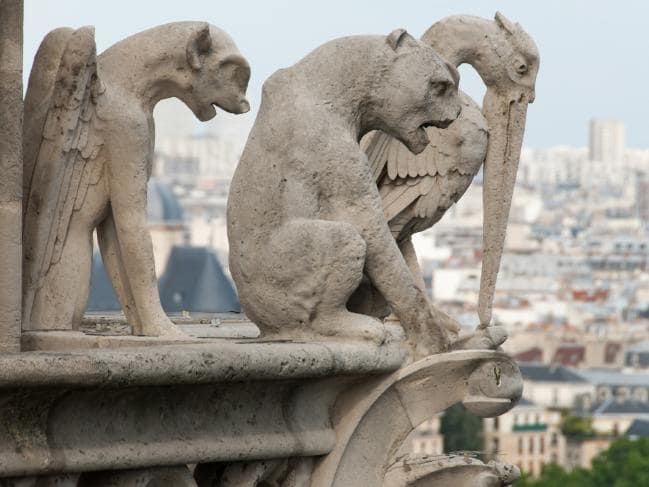Huge vaulted ceilings and giant ornamental stained glass windows cast a beautiful light over the 850-year-old building.
From the outside, its towering sandstone facade is watched over by hand-carved gargoyles.
It’s little wonder most view Notre Dame as the soul of Paris.
But its significance goes far beyond its beauty. The Gothic cathedral was, until Monday, home to priceless artefacts and relics linked to Jesus Christ.
As the city wakes to assess the damage caused by an out-of-control fire that destroyed the church’s famous spire and much of its roof, historians and the art world will hold their collective breath.
What we know so far is that the Crown of Thorns — long considered Paris’ equivalent of the Crown Jewels — was rescued by firefighters.

The Crown of Thorns was spared in the fire. Picture: Philippe Lopez/AFPSource:AFP
The relic came from Jerusalem and dates back to Jesus’ crucifixion. It was kept with a fragment of the cross and one of the nails where Jesus Christ was said to have been crucified, but it’s not clear whether both were saved.
Smoke poured out of the cathedral’s spire before flames erupted shortly after 6.50pm local time (2.50am AEDT). The spire itself collapsed soon after and it’s not yet clear if the relics at the summit were able to be saved.
Laurent Ferri, a curator at the Division of Rare and Manuscript Collections at Cornell University told Bloomberg the relics inside were “now likely reduced to ashes”.
If some were lost, many more were saved. The city’s mayor, Anne Hidalgo, said most of the significant artwork and holy objects inside were recovered.
France’s culture minister Franck Riester shared images of priceless artworks being loaded into trucks.
Notre Dame’s intricate and enormous stained glass windows — referred to as the Rose Windows — face west, north and south.

The church’s famous gargoyles. Source:istock
Early reports from firefighters at the scene suggested the three Rose Windows — which date back to the 13th century — had been blown out by the sheer scale and ferocity of the fire.
“They exploded because of the heat of the blaze,” a firefighter said, but footage after the fire was contained appeared to show one of the rosette’s intact.
Julio Bermudez, professor at the school of architecture and planning at Catholic University in Washington D.C said the stained glass was “really irreplaceable”.
Other significant historical artefacts inside Notre Dame include the giant organ which contained pipes from the Middle Ages and an archaeological crypt under the church’s courtyard.
The condition of the organ and the crypt are not known.
The twin bell towers that greet the 14 million visitors to the cathedral every year were spared despite earlier warnings that everything would be lost.
The bell in the south tower rang out to mark the end of World War II.
Barbara Drake Boehm, senior curator at the Metropolitan Museum of Art’s medieval Cloistersbranch in New York, told the Associated Press the significance of everything inside is greater than the individual elements.

The intricate stained-glass windows at Notre Dame. Picture: Ludovic Marin/AFPSource:AFP
“It’s not one relic, not one piece of glass — it’s the totality,” she said,
“It’s the very soul of Paris, but it’s not just for French people. For all humanity, it’s one of the great monuments to the best of civilisation.”
Journalist Dan Rather captured that same sentiment, tweeting: “We recognise in this cathedral our common humanity.”
Many Parisians will be waking up to a different skyline and an attraction that has been devastated. Some likely did not sleep.
Around the cathedral on the bank of the River Seine, many stayed up well past midnight. They were in shock.
Others sang to express their sadness and collective grief.
The burning of Notre Dame is being treated as an accident by authorities, but it will likely be some time before the exact cause is known.
The fire is believed to have started in scaffolding around the spire where millions of dollars worth of restoration works had begun in an effort to keep the church pristine for future generations.
Sadly, they’ll never see it the way it once was.
Courtesy News.com.au

